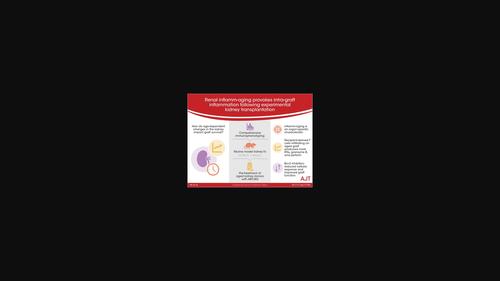当前位置:
X-MOL 学术
›
Am. J. Transplant.
›
论文详情
Our official English website, www.x-mol.net, welcomes your feedback! (Note: you will need to create a separate account there.)
Renal inflamm-aging provokes intra-graft inflammation following experimental kidney transplantation
American Journal of Transplantation ( IF 8.8 ) Pub Date : 2022-07-19 , DOI: 10.1111/ajt.17154 An He 1 , Attia Sarwar 1 , Linda Marie Laura Thole 1 , Janine Siegle 1 , Arne Sattler 1 , Muhammad Imtiaz Ashraf 2 , Vanessa Proß 1 , Carolin Stahl 1 , Theresa Dornieden 1 , Yasmin Bergmann 1 , Paul Viktor Ritschl 2 , Susanne Ebner 3 , Karolin Wiebke Hublitz 4 , Efstathios Gregorios Stamatiades 4 , Roman David Bülow 5 , Peter Boor 5 , Katja Kotsch 1
American Journal of Transplantation ( IF 8.8 ) Pub Date : 2022-07-19 , DOI: 10.1111/ajt.17154 An He 1 , Attia Sarwar 1 , Linda Marie Laura Thole 1 , Janine Siegle 1 , Arne Sattler 1 , Muhammad Imtiaz Ashraf 2 , Vanessa Proß 1 , Carolin Stahl 1 , Theresa Dornieden 1 , Yasmin Bergmann 1 , Paul Viktor Ritschl 2 , Susanne Ebner 3 , Karolin Wiebke Hublitz 4 , Efstathios Gregorios Stamatiades 4 , Roman David Bülow 5 , Peter Boor 5 , Katja Kotsch 1
Affiliation

|
Donor age is a major risk factor for allograft outcome in kidney transplantation. The underlying cellular mechanisms and the recipient's immune response within an aged allograft have yet not been analyzed. A comprehensive immunophenotyping of naïve and transplanted young versus aged kidneys revealed that naïve aged murine kidneys harbor significantly higher frequencies of effector/memory T cells, whereas regulatory T cells were reduced. Aged kidney-derived CD8+ T cells produced more IFNγ than their young counterparts. Senescent renal CD8+ T and NK cells upregulated the cytotoxicity receptor NKG2D and the enrichment of memory-like CD49a+CXCR6+ NK cells was documented in aged naïve kidneys. In the C57BL/6 to BALB/c kidney transplantation model, recipient-derived T cells infiltrating an aged graft produced significantly more IFNγ, granzyme B and perforin on day 7 post-transplantation, indicating an enhanced inflammatory, cytotoxic response towards the graft. Pre-treatment of aged kidney donors with the senolytic drug ABT-263 changed the recipient-derived effector molecule profile to significantly reduced levels of IFNγ and IL-10 compared to controls. Graft function after ABT-263 pre-treatment was significantly improved 28 days post kidney transplantation. In conclusion, renal senescence also occurs at the immunological level (inflamm-aging) and aged organs provoke an altered recipient-dominated immune response in the graft.
中文翻译:

肾脏炎症老化在实验性肾移植后引发移植物内炎症
供体年龄是肾移植同种异体移植结果的主要危险因素。尚未分析老化同种异体移植物中潜在的细胞机制和受体的免疫反应。幼稚和移植的年轻肾脏与老年肾脏的综合免疫表型分析表明,幼稚的老年小鼠肾脏具有明显更高频率的效应/记忆 T 细胞,而调节性 T 细胞减少。老年肾来源的 CD8 + T 细胞比年轻的细胞产生更多的 IFNγ。衰老肾 CD8 + T 和 NK 细胞上调细胞毒性受体 NKG2D 和记忆样 CD49a + CXCR6 +的富集NK 细胞存在于年老的幼稚肾脏中。在 C57BL/6 至 BALB/c 肾移植模型中,浸润老化移植物的受体衍生 T 细胞在移植后第 7 天产生明显更多的 IFNγ、颗粒酶 B 和穿孔素,表明对移植物的炎症和细胞毒性反应增强。与对照组相比,用衰老药物 ABT-263 对老年肾脏供体进行预处理改变了受体来源的效应分子谱,从而显着降低了 IFNγ 和 IL-10 的水平。ABT-263 预处理后的移植物功能在肾移植后 28 天得到显着改善。总之,肾脏衰老也发生在免疫水平(炎症老化),衰老的器官会在移植物中引起受体主导的免疫反应发生改变。
更新日期:2022-07-19
中文翻译:

肾脏炎症老化在实验性肾移植后引发移植物内炎症
供体年龄是肾移植同种异体移植结果的主要危险因素。尚未分析老化同种异体移植物中潜在的细胞机制和受体的免疫反应。幼稚和移植的年轻肾脏与老年肾脏的综合免疫表型分析表明,幼稚的老年小鼠肾脏具有明显更高频率的效应/记忆 T 细胞,而调节性 T 细胞减少。老年肾来源的 CD8 + T 细胞比年轻的细胞产生更多的 IFNγ。衰老肾 CD8 + T 和 NK 细胞上调细胞毒性受体 NKG2D 和记忆样 CD49a + CXCR6 +的富集NK 细胞存在于年老的幼稚肾脏中。在 C57BL/6 至 BALB/c 肾移植模型中,浸润老化移植物的受体衍生 T 细胞在移植后第 7 天产生明显更多的 IFNγ、颗粒酶 B 和穿孔素,表明对移植物的炎症和细胞毒性反应增强。与对照组相比,用衰老药物 ABT-263 对老年肾脏供体进行预处理改变了受体来源的效应分子谱,从而显着降低了 IFNγ 和 IL-10 的水平。ABT-263 预处理后的移植物功能在肾移植后 28 天得到显着改善。总之,肾脏衰老也发生在免疫水平(炎症老化),衰老的器官会在移植物中引起受体主导的免疫反应发生改变。



























 京公网安备 11010802027423号
京公网安备 11010802027423号